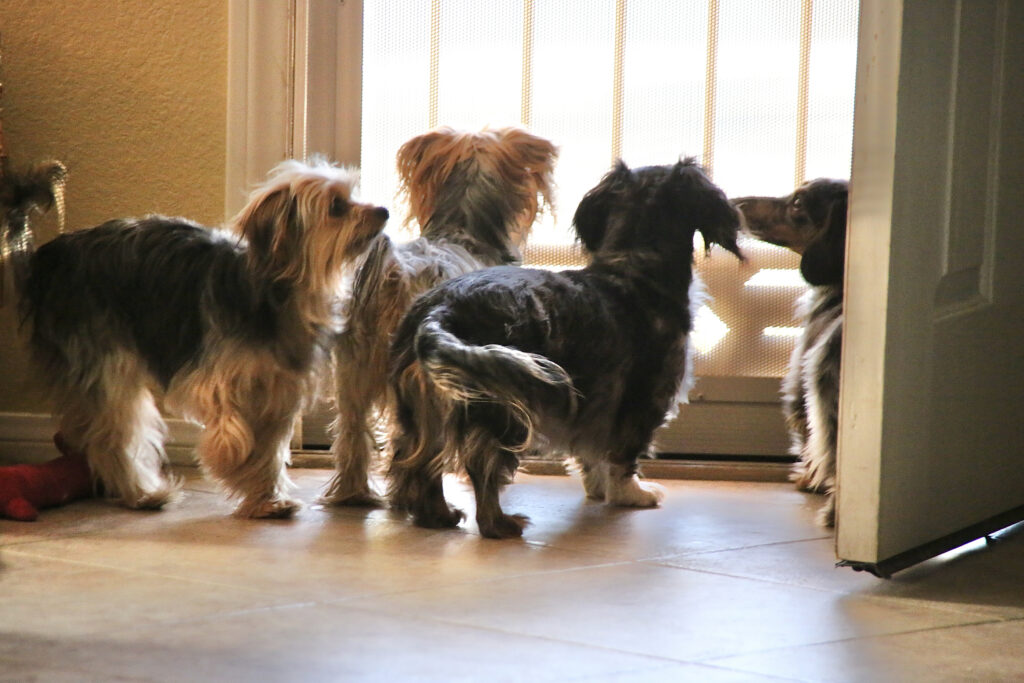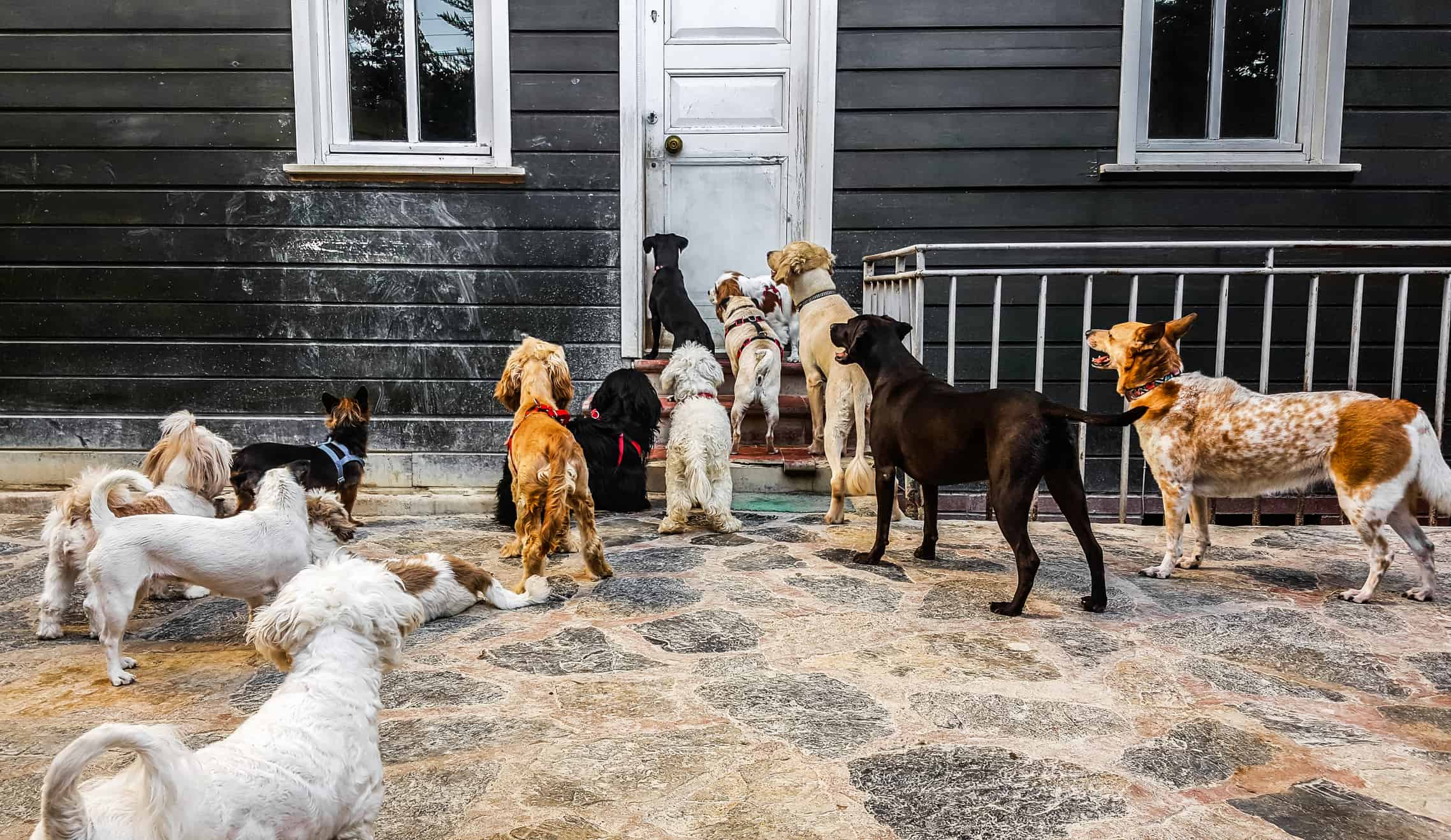We know, we know. How can there be such a thing as “too many” dogs?
For some families, it seems that once you surpass four or five dogs, adding another one is as simple as just putting another bowl down during dinner. On the other hand, for households owning only one dog, taking the step to bring an additional dog into the home can appear enormous.
According to the latest available data from the American Veterinary Medical Association, out of the 62 million households owning dogs in the United States, the average number of dogs owned is 1.46. That average means that while there are obviously some households that are content with owning just a single dog, there are also a significant number owning two or more dogs. This marries up with our Pet Dog Owner Survey we carried out a few years ago, where almost forty percent of respondents said they owned three or more dogs.
In answer to the question posed by the title of this article, in reality, the number of dogs that can be classified as “too many” will vary from home to home, family to family, and circumstance to circumstance. In this article, we’re going to review some of the factors you should consider when deciding whether or not to add another four-legged member to your family.
The benefits of owning more than one dog
From a dog’s perspective, there are actually numerous benefits to being in the presence of other dogs. Being in the company of fellow pups creates socialization and harmony, prevents loneliness and boredom, and encourages exercise and play. It can also create natural learning opportunities if you have a well-trained, older dog, who can help a younger dog to understand what is appropriate behavior (and what isn‘t).
Multiple dogs in a household can also be beneficial for humans. Watching how multiple dogs interact with one another can be similar to watching siblings play together – and it can be rewarding to see how their relationships develop over time.
What to consider when thinking about getting another dog
If your family already owns a dog and is thinking about getting another one, there are several things you should consider before proceeding. Of course, if you already own multiple dogs and are an experienced dog owner, then integrating another canine into the mix may not seem like a big deal. But if you’re currently a single dog household, these factors should be carefully considered.
Your current dog(s)
Bringing another dog into the home will require a big adjustment from the dog(s) already part of your family. Your current pup will receive less attention and may appear initially resentful if they feel they must compete for resources with the new family member.
You should also carefully consider the size, energy and temperament of the dogs currently in your household. Generally speaking, you won’t want to pair a tiny dog with a large one, as this could cause accidents or injuries during play. In addition, you’ll ideally want a breed that can match the energy and personality of your existing dog. Introducing a lower-energy dog with a dog who wants to play throughout the day will simply create frustration between the two.
Finally, you should bear in mind any previous behavioral problems that your dog has experienced. This should then be considered alongside any concerns you may have about your potential new addition. If adopting from a shelter, refer to our list of questions you should ask shelter staff to establish if a dog is likely to be a suitable addition to your family.

Space
If you’re limited on space – whether indoor or outdoor – this may have a bearing on your decision to obtain another dog.
For example, if you are living in an apartment and are already pushed for space with your existing pet, introducing another dog may make things start to feel very claustrophobic. Remember that it is not only your dogs who will need enough space – they will have toys, crates and training equipment that will also take up room.
If you are considering adopting a high-energy breed, you will likely need room in your backyard to allow them to run. If your yard is limited on space with your existing dog, it may begin to appear crowded with another one in the mix.
Budget
Just owning one dog can be an expensive pastime. Owning two dogs is more expensive than owning one dog, although the costs don’t necessarily double, as you may be able to re-use the same equipment for both dogs (grooming supplies, treats, food, etc.). With that said, there will be some initial upfront expenditure for collars, leashes and other items, and costs accrue over time with increased food costs and veterinarian visits. You may also need to allocate funds for dog training. If your household budget is already pushed to its limit, introducing another dog could tip it over the edge.
Home dynamics & family circumstances
This isn’t just about the other pets in the home. This is about your life, your structure, your routine, and how a new dog could affect those.
Let’s say you bring home a new puppy. When you start to potty train your pup, you’ll need to let them out of their crate every two to three hours. If the adults are at work and the kids are at school for the majority of the day, who will do that? These are the types of considerations and discussions that your family should have before deciding to add an extra dog to your home.
Remember, even if you can bring a new dog home, it doesn’t mean you should. Pets are an added responsibility on top of parenting, work, school, hobbies, and everything else that is happening in our lives. Make sure that you and your family are in a position to take care of a new dog and give it the quality of life it deserves.

How to make owning multiple dogs easier
While owning multiple dogs can bring its own unique stressors, there are ways to mitigate and manage these situations. These tips can help to ensure a harmonious household.
- Structured introduction – Don’t just introduce your new dog and ‘hope for the best’. Have a plan to systematically introduce new dogs to other dogs in the home. Consider introducing the dogs away from the home environment first, where the current dog may feel protective of its surroundings.
- Feeding – Make sure to feed dogs in different areas of the room so they do not feel they have to fight for resources.
- Invest in training – Basic obedience training offers you control. A professional dog trainer should also be able to help you integrate your new dog into your home successfully.
- Be calm and patient – Bringing a new dog home can be testing, but a calm demeanor is more likely to be helpful. Patience is truly a virtue.
- Supervision – Especially when they are getting accustomed to one another, never leave dogs unsupervised, whether inside or outside of your home. Watch their behavior constantly for warning signs or triggers that could lead to conflict, and try to resolve these before they have the potential to escalate into something worse.
In conclusion
There are those of us who can never have enough dogs – and those of us who are happy with just one.
The fact is that there is no number that we can simply state as “too many” dogs, because there are any number of variables that can impact home and family circumstances. All we can advise is to take the information above into account when you start to think about introducing a new dog into your life – it is better to consider these aspects beforehand than to try and resolve them afterwards.


You must be logged in to post a comment.